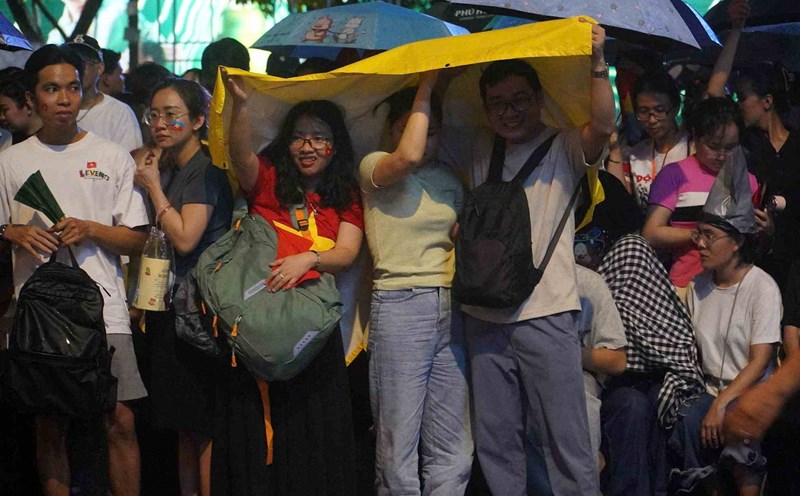4:50 p.m.: Concluding remarks of the Workshop: Ms. Ha Thu Giang - Director of the Department of Credit for Economic Sectors - State Bank of Vietnam:
Through the opinions of businesses, experts... in today's workshop, we clearly see the role of green credit today, the active proactiveness of participation of banks. At the same time, through the identified opinions, green credit is one of the important resources along with other resources such as FDI attraction, corporate bonds... contributing to the country's green growth target.
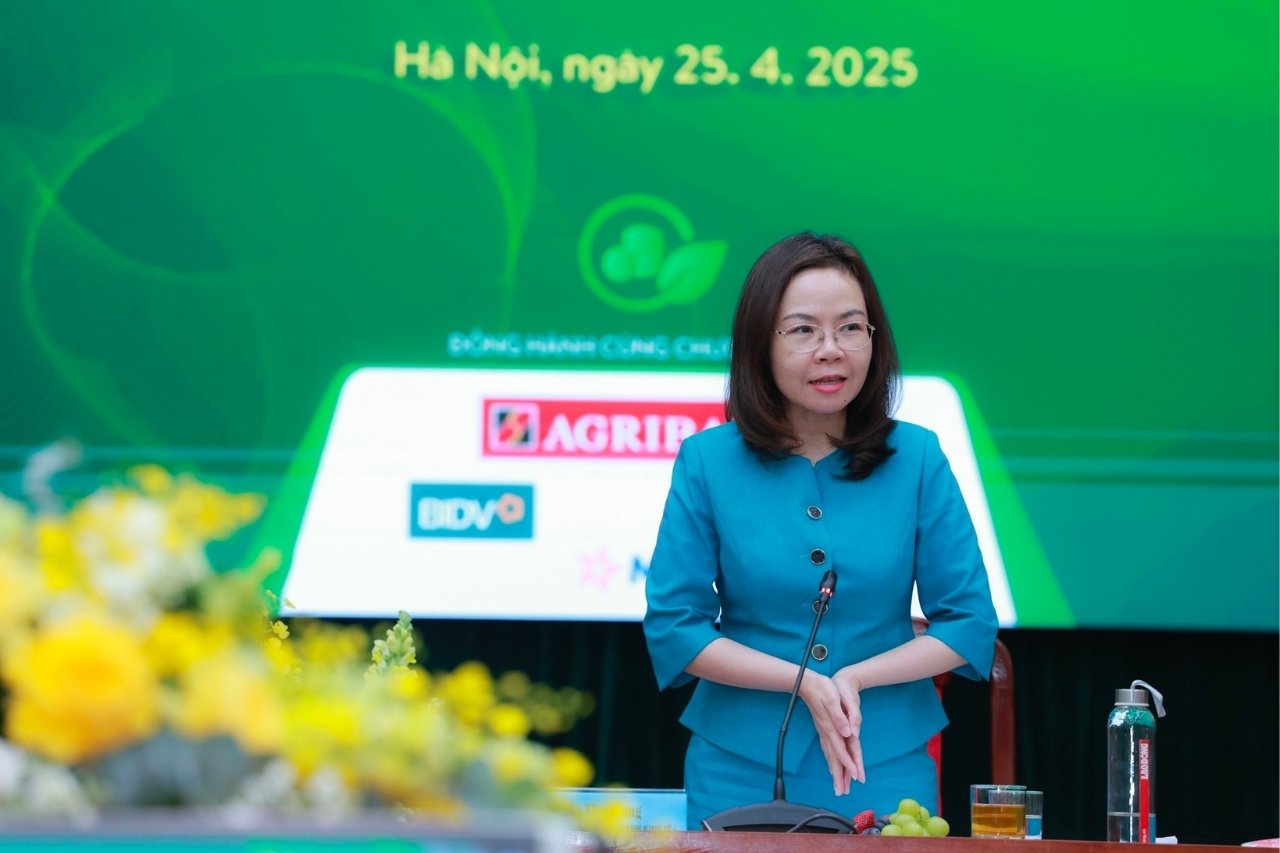
Developing green credit is one of the solutions that credit institutions have been orienting to contribute to the process of sustainable development, meeting international standards. Thereby, affirming the position and improving the bank's competitiveness.
For businesses and people, green credit is one of the resources to support people to improve technology and contribute to business development.
Through the Workshop, we can see that green credit in Vietnam has favorable conditions for development, opportunities for continued development, thereby actively contributing to sustainable economic development.

Right from the beginning, we have had clear orientations and regulations to how to shift and develop a green economy. We also acknowledge the proactiveness and active participation of banks in implementing solutions; at the same time, we also receive synchronization from state management agencies and SBV in issuing policies and strategies as well as actively following the direction of SBV; proactively learning from international experiences to research solutions to develop green fields. At the same time, proactively seek and diversify investment capital sources, contributing to greening the credit portfolio.
Right from the opinions discussed at the Workshop of the two pioneering banks in implementing green credit capital, through solutions of the State Bank and credit institutions, the results of green credit growth achieved growth in both scale and speed. Thereby, contributing to an increasingly higher proportion of the total outstanding debt of the economy.
Through the opinions at the Workshop, we also clearly see the problems in expanding green credit. These difficulties and problems also include the possibility of the Green Classification List being issued soon to create a basis for credit institutions to lend. Thereby, it is possible to assess more securely the capital that has been and is being invested.
The second difficulty is technical expertise in the field of green and environmental protection. This requires human resources to be trained, fostered, and updated to meet the requirements in the coming time - in the process of considering lending projects. We also see that resources from bank credit are just one of the investment resources to promote green economic development. We also really need preferential sources from the state budget, resources from international organizations... thereby diversifying investment sources.
On the banking sector's side, in the presentations of banks in the Workshop, banks determined to continue to accompany and support businesses in the green transformation process.
In the coming time, the SBV as well as credit institutions will continue the activities that have been and are being implemented, contributing to the implementation of green goals, promoting green credit, thereby contributing to green growth. Specifically, focus on reviewing and perfecting the legal corridor for the banking sector in general; propose that ministries, branches and localities have more opinions to synchronize solutions on land, environment, planning... Thereby, creating maximum conditions for businesses, people as well as the banking sector itself to promote green credit in Vietnam.
At the same time, it will continue to monitor more from credit institution systems. When the Green Classification List is issued, the SBV will have guiding and directing documents as soon as possible.
16:35: open discussion with delegates and audiences interested in the Workshop
As someone interested in green credit and sustainable development projects with the environment, Associate Professor, Dr. Nguyen Thuong Lang expressed his opinion: "In new conditions, we should apply more flexibly. With the market of green products, green growth, and an increasingly large green economy, our customer base is not commensurate despite its large scale, high profits, and attractiveness equal to its importance. At the same time, the effort is every hour, every minute, the level of readiness is high, even for businesses and research agencies.
Associate Professor, Dr. Nguyen Thuong Lang hopes that green technology can further apply Resolution 57 on digital transformation and green technology. This is a Resolution on innovation, digital transformation, applying green technology to increase risk acceptance. This requires great support from the State.
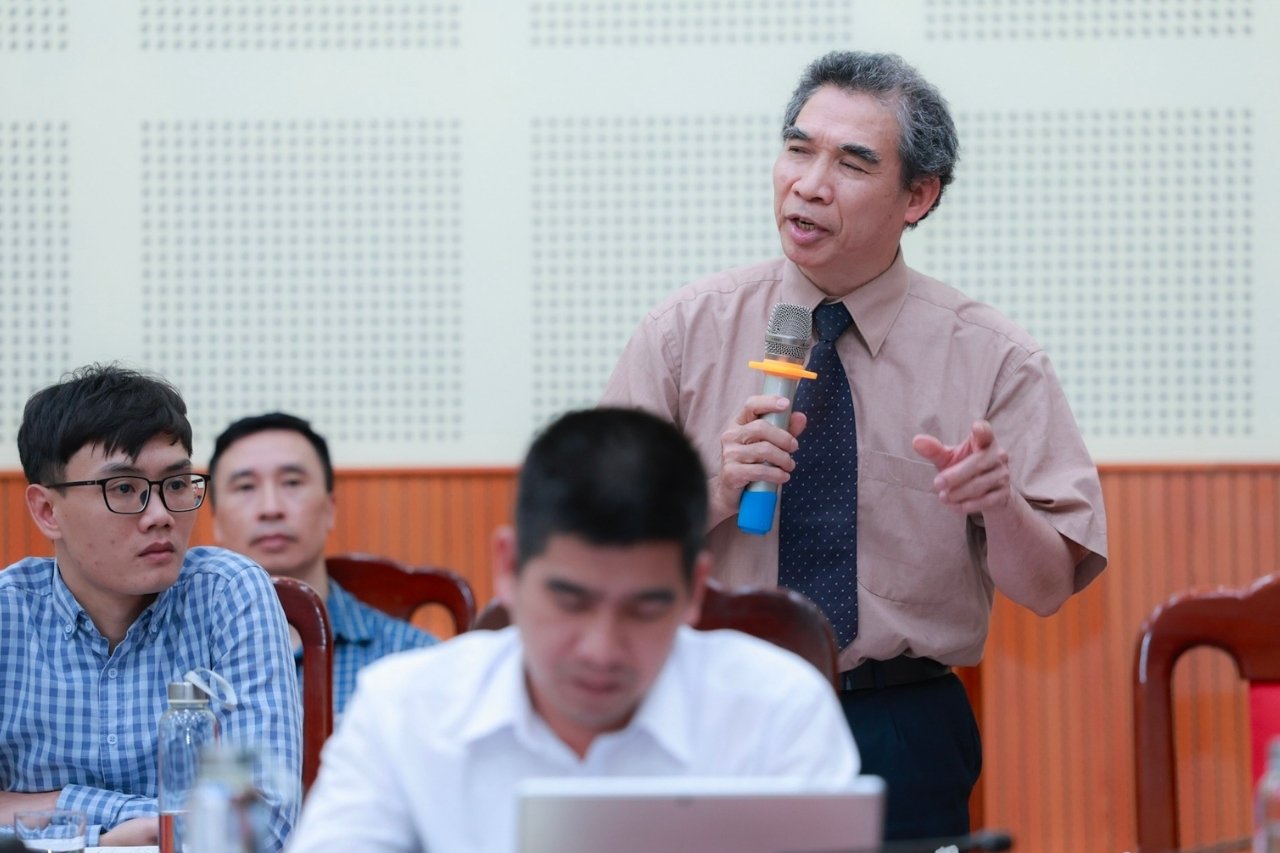
Second, the Resolution on private economic development, prioritizing private enterprises, needs to be increased. The higher risk acceptance for these two subjects must be higher than the average or the lower risk acceptance must be average. Reliability will be pushed higher in institutions and accompanying policies.
For projects and items successfully exported to demanding markets, it is necessary to pump stronger green credit capital. Because we can sell outside, we can definitely get safe cash flow, businesses and people are safe.
On the contrary, for domestic products and services that do not have a large market, they should not pump too much because the risk is quite high.
Strategy to promote green credit at BIDV
16:34: Mr. Vuong Thanh Long - Deputy Head of the Investment and Development Joint Stock Bank, Vietnam Joint Stock Commercial Bank
According to Mr. Vuong Thanh Long, in the context of the trend of sustainable development spreading strongly globally, businesses in Vietnam will increasingly face greater pressure from many sides - including increasingly strict legal regulations of the State, strict requirements from international investors (in contributing capital or lending), and from customers and partners in the value chain ( Suppliers, distributors, buyers) on environmental and social responsibility.
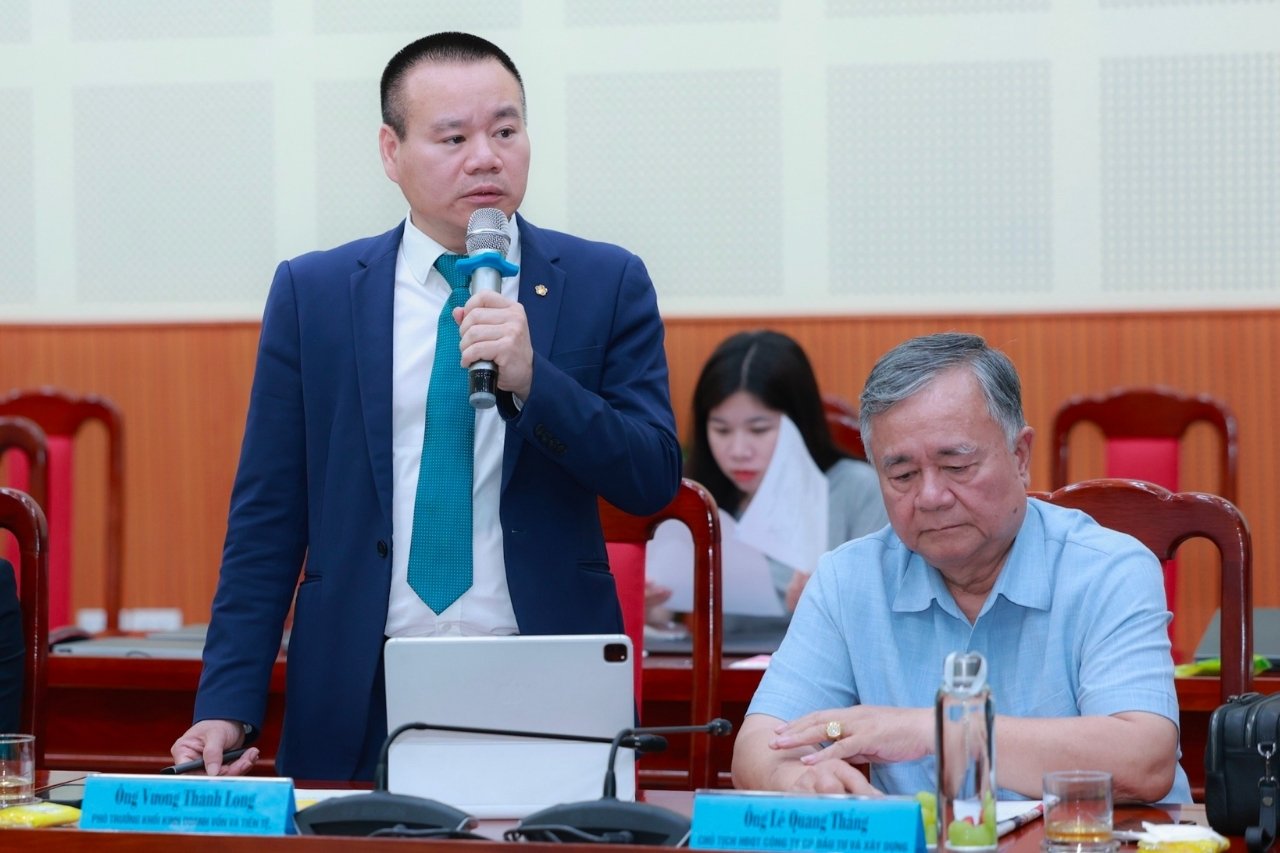
Green transformation meets the above environmental and social responsibility requirements, businesses, especially SME businesses, are currently facing some major barriers, including high initial investment costs because the ability to access long-term capital with preferential interest rates is still limited.
In this context, the green finance is designed with the orientation as a tool to support businesses to access financial resources to gradually change the ESG production and business model. In particular, the bank plays a central role in the green financial ecosystem - not only a direct capital supplier, but also a guide, guiding, connecting partners and promoting the green conversion journey of the business. As a pioneer in this field, BIDV is proud to be the leading bank in the Green Financial Market in Vietnam, owning a rich product list - from green loans, green bonds, green deposits to green trade sponsorship - with the scale of green credit balance as of 31.12.2024 reaching nearly 81 trillion dong, accounting for about 12% of the green credit market share of the banking industry " - Mr. Vuong Thanh Long.
Recognizing the role and significance of green growth, Mr. Vuong Thanh Long said - right from the time of developing a business strategy for the period 2021-2025 with a vision to 2030, BIDV has established the goal of "creating sustainable value" as a consistent goal in the bank's operations, in which it will soon focus on green transformation, financing and seeking and increasing capital sources to finance green and sustainable projects in building an overall green strategy for BIDV. By 2030, BIDV will continue to promote green finance, while converting its operations to become a green bank.
Since 2018, BIDV has restricted credit in the fields of fossil energy (thermal power, coal power ...), large hydroelectric projects, and greenhouse emissions projects. By 2035, BIDV will have no outstanding loans for thermoelectric and coal projects. In 2022, BIDV established a sustainable financial project management board for research, advice, advising, building and deploying sustainable finance at BIDV; ESG risk management in credit activities; And the orientation of BIDV becomes Net-Zero Bank in business activities according to domestic and international green and international standards. In 2023, BIDV strengthened the establishment of the Steering Committee to develop and implement the sustainable development strategy and practice the overall ESG to replace the sustainable Financial PMU. This is an important mark and affirms the determination of the entire BIDV system in practicing ESG.
Although our country does not have criteria, international partners do. We have built green financial frameworks in all areas of operation to ensure the organization, operation and governance of banks in accordance with the established sustainable development strategy Mr. Vuong Thanh Long informed.
Accordingly, in 2019, BIDV issued an environmental - social risk management framework applicable to international loan sources (ESMS). BIDV is the first bank to issue an ESMS Framework in Vietnam to ensure compliance with green criteria in the lending process and post-lending management, developed with the consultancy of the Asian Development Bank (ADB). The ESMS framework applies to loans from ADB's entrusted capital as a basis for BIDV to manage environmental and social risks for credit granting activities from other commercial capital sources, as well as continue to research and perfect the application for all credit granting activities of BIDV.
The sustainability loan framework was developed and issued by BIDV in 2023 with the consultancy of the UK Government and the carbon Trust and was rated by Moody's at SQS2 (very good - very good). BIDV is the first bank to issue a Sustainable Loan Framework, as a basis for classifying sustainable projects with conventional commercial projects, thereby helping the bank build specific policies and promote sustainable credit granting activities for customers.
Green bond and sustainable bond framework: In 2023 and 2024, with the technical support of the World Bank, BIDV has completed and issued a Green and Sustainable Bond framework according to the principles/instructions of the International Capital Market Association (ICMA) to mobilize capital for NH's ESG financing activities. Both ESG bond frameworks of BIDV are highly appreciated by Moody's Credit Rating Organization for their compliance with international principles as well as management measures and capital use reporting with the SQS2 score (very good - very good).
According to Mr. Vuong Thanh Long, following the issued financial frameworks, BIDV has also implemented sustainable financial solutions to advise, guide, and support businesses in implementing projects that meet green criteria, thereby contributing to promoting the development of the sustainable financial market in Vietnam.
Practicially implementing sustainable financial solutions, BIDV has built a rich portfolio of green finance products, suitable for the actual needs of businesses. We build and provide preferential loans for green projects that meet sustainability criteria, including green credit, sustainable linkage loans (SLL) with interest rates associated with specific ESG KPI targets, as well as ESG bond issuance consulting services.
BIDV deploys credit packages with technical assistance services and preferential policies to address the practical difficulties that many businesses face in meeting ESG criteria. We combine capital provision with in-depth technical consulting, helping businesses prepare sustainability reports, inventory greenhouse gas emissions and complete green certificates. BIDV's preferential credit policies and packages are also applied to key industries that need green transformation such as textiles, green works, and clean water, with a scale of up to about 20,000 billion VND. We also reduce service fees for transactions applying environmental and social risk assessment" - Mr. Vuong Thanh Long informed.
In addition, BIDV has cooperated closely with international financial institutions such as ADB, AFD and many other partners to implement preferential loan programs. At the same time, we provide comprehensive consulting services to help businesses access international funding sources and implement sustainable financial strategies, thereby creating favorable conditions for businesses to participate in international financial markets.
In addition, BIDV actively connects businesses with the ESG service ecosystem through a network of reputable partners. We provide a list of international standard ESG consulting and auditing partners, supporting connections with ESG confirmation and rating service providers; at the same time, proactively building a platform to connect businesses and experts in the ESG field, helping businesses prepare to participate in sustainable financial opportunities.
Along with that, BIDV provides consulting and support services with full information on green finance and ESG. We organize in-depth seminars, provide updated documents on policies, regulations and market trends, and guide businesses to build green transformation roadmaps, assess ESG risks and prepare green loan applications, helping businesses prepare to participate in sustainable financial opportunities.
BIDV also cooperates with technology partners to deploy green and digital technology solutions in ESG management for corporate customers. We support businesses in accessing green technologies to reduce carbon and optimize energy and resources. In addition, we connect businesses with ESG measurement and reporting platforms, including ESG data tracking tools and greenhouse gas inventories, supporting businesses to report sustainable development effectively.
Mr. Long said that all of the above solutions aim to build a comprehensive ecosystem, fully meeting all needs of businesses in the green transformation journey, from access to information, raising thinking, awareness, to grasping standards, criteria, conditions, solutions on technology, digitalization, measurement, ESG reporting... In which an important step is to successfully access preferential green financial products and packages.
With a clear strategic orientation and a system of practical solutions being implemented synchronously, BIDV identifies green finance as both a development goal and a method to realize its commitment to accompany businesses in the green transformation journey.
Effective use of green financial instruments not only helps businesses save costs, but also increases awareness and good practices, meeting ESG requirements, thereby enhancing the capacity to expand international cooperation and competition opportunities.
In the coming time, BIDV is committed to continuing to expand its portfolio of green/sustainable financial products to serve customers, while promoting the integration of ESG elements in all banking activities. We will continue to accompany and support businesses in accessing appropriate financial resources, improving their implementation capacity and working towards the goal of sustainable, inclusive and prosperous development.
"In the coming time, I hope that the State will quickly have regulations on how to determine green standards so that policy beneficiaries can enjoy their rights. At the same time, policy programs to promote sustainable projects can remain stable. The SBV can recognize and encourage commercial banks and pioneering green financial institutions to demonstrate through numbers for banks to continue banking. Especially for risky, vulnerable sectors such as agriculture, a risk reserve fund can be built so that businesses have a better development plan" - Mr. Vuong Thanh Long suggested.
To provide green loans, banks also need to remove difficulties
16:07: Ms. Phung Thi Binh - Deputy General Director of Agribank:
After listening to the opinions of the delegates, Agribank sympathized with the story of businesses when they had difficulty accessing green loans. However, this is not an isolated case many businesses are currently facing similar difficulties in the process of accessing green credit.
In fact, from around 20122013, Vietnam has had a pilot program with 15 agricultural production value chains. In seminars and conferences, the leaders of the State Bank have also mentioned it many times. Of the 15 models, only a few have been effective, while the majority of the rest have not delivered the expected results. For example, the model of growing orchids in Da Lat - despite careful investment, has not yet achieved clear results.
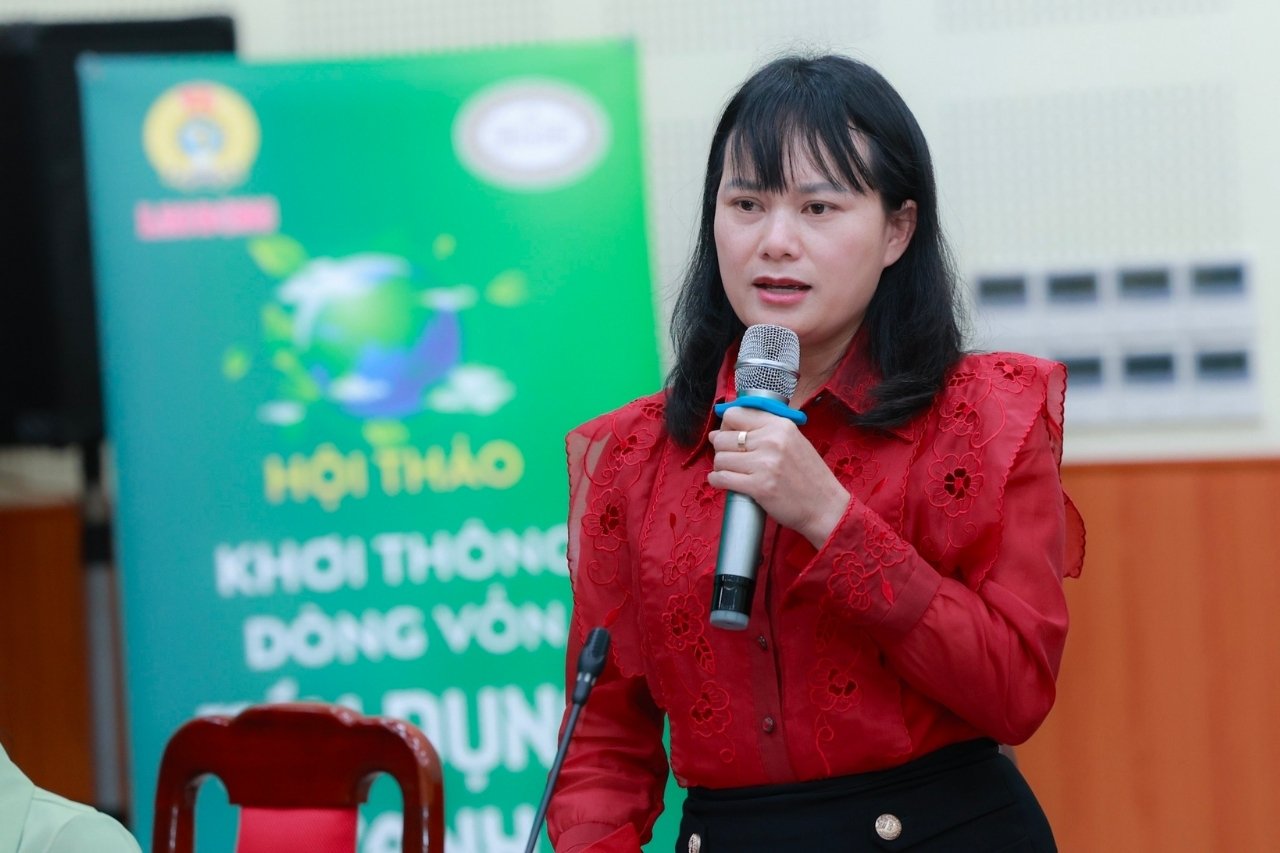
Learning from those projects, the current 1 million hectare rice emission reduction program is being implemented by Agribank in a completely different way: production according to the value chain. There, the lending is carried out synchronously for all stages - from the unit providing seeds, fertilizers, pesticides to farming households and final purchasers. Each party participating in the chain has a clear responsibility.
In case all components participate and borrow capital synchronously, the bank can apply a deeper preferential interest rate - reduced by up to 1.52%. Conversely, if only borrowing individual stages, the preferential rate will be lower. This is the current necessary lending mindset to ensure efficiency and capital recovery.
However, there is still a huge problem related to collateral. Many businesses that rent land with annual payments or are not eligible for a land use right certificate, so according to regulations, banks cannot mortgage land use rights. In that case, it is only allowed to receive assets invested on land - such as greenhouses, greenhouses - but these assets are very difficult to specifically valuate, not eligible for mortgage.
Proposals to record assets invested in land as legally owned assets have been made many times, but so far there has been no change. This is a major barrier, making it difficult for banks to disburse even if they really want to lend.
In the process of implementing green credit projects, many shortcomings can be clearly seen. According to statistics, Agribank currently has about VND29,000 billion classified as green credit, but in reality, this figure may be even larger - because many loans cannot be identified correctly because there is no official classification framework.
Up to now, there has not been a specific Decree or green classification portfolio system to serve as a basis for determining projects that are eligible for green credit. This makes it impossible to count many potential loans or access them in accordance with policies.
reality also shows that many businesses that want to export must meet strict criteria not only in terms of products but also in the production process. Previously, many facilities used coal boilers, but now they have had to switch to bio-compressed tablets or bio-olations to meet standards. However, these changes have not been fully reflected in current green credit statistics.
In the field of renewable energy, Agribank is very eager to participate, especially in solar power and biomass power. However, the continuous adjustment policy especially in electricity planning makes the assessment of investment efficiency unstable, creating a fear for banks when implementing lending.
A typical case is the waste-to-energy project in Quang Ninh. Agribank has invested in a complex of four factories, including a wastewater and waste treatment plant. However, another factory was later licensed in the same area, leading to insufficient waste to ensure effective operation. Lack of synchronous planning makes capital recovery difficult.
Biomass is a very potential model - from afforestation, timber exploitation to power generation - but there is currently no specific efficiency calculation mechanism. Commercial banks need to have enough basis to evaluate investment efficiency before lending, otherwise they will have to bear all risks when an incident occurs.
Developing green growth is inevitable, but for banks and businesses to meet each other, a clear and synchronous support mechanism is needed.
Therefore, we have 2 recommendations:
First, it is necessary to soon issue a green classification system that meets specific criteria, so that banks have a basis for appraisal and lending implementation.
Secondly, Agribank is a bank that mainly mobilizes capital from residents - about 80% is long-term deposits with high interest rates - so it is necessary to allocate cheap capital from international organizations, such as carbon credit sales revenue or the 1 million hectare rice program, to implement green lending effectively and in the right direction.
In reality, many green projects are facing difficulties due to the lack of appropriate appraisal and confirmation tools. Despite fully complying with regulations from environmental impact assessment to environmental risk management banks cannot determine their own greenness without an intermediary to confirm.
The recommendation is: if the project uses the state budget or international funding, there needs to be a clear green certification mechanism. As for commercial loans, banks should not be forced to carry out confirmation procedures themselves - because if risks occur, the responsibility will belong to the bank.
Another problem is the valuation of collateral. Assets invested in agricultural land - such as greenhouse and irrigation systems - are not currently recognized as mortgaged assets, although they have been proposed for recognition many times.
In the agricultural sector, to recover capital for a project, businesses need to operate extremely effectively. While this is a very high-risk industry, requiring specific policies and practical support.
I hope that ministries and branches will coordinate to build synchronous policies, helping green credit to be effectively implemented. Commercial banks are completely ready to accompany, if there is a clear legal framework and sufficient conditions for effective and sustainable lending.
Voice from the business
15:45: Mr. Le Quang Thang - Chairman of the Board of Directors of Viet Long Investment and Construction Joint Stock Company:
The green economy is moving towards a sustainable development model. A country that wants to truly develop sustainably must not only protect the environment but also improve the environment for the better.
A business that wants sustainable development must choose a circular production plan or a product value chain, which is the green economy, so since its establishment, the company has made great efforts to successfully build and develop a production and service business towards a green environment in both the main areas of waste treatment and safe food production and trading.
For waste treatment:
Every day, the company typically destroys an average of 500 tons of household waste and common industrial waste.
Up to now, the domestic waste treatment capacity has reached about 400 tons/day using 100% unclassified incineration technology. (treating bothun and leachate), no landfill; during the treatment process, no wastewater is generated into the environment; the surrounding air quality and emissions are guaranteed to be QCVN; ash and slag are used to produce construction materials (production of block bricks).
For clean agricultural production:
Since 2012, the Company has invested in the agricultural sector in the direction of developing clean agriculture with a production model in the form of a product value chain with the motto of linking 3 houses: farmers, scientists, businesses, forming a group of farming households to attract agricultural land areas, human resources...
The operational orientation of our company in the following years:
Continue to maintain and expand the scale of waste treatment to meet the needs of domestic waste treatment.
Add industrial waste treatment lines (Serving industrial parks)
For the agricultural production sector: Focus on applying digital transformation, improving science and technology to research the production of clean vegetables, clean agricultural products, and improving productivity to meet the needs of the community.
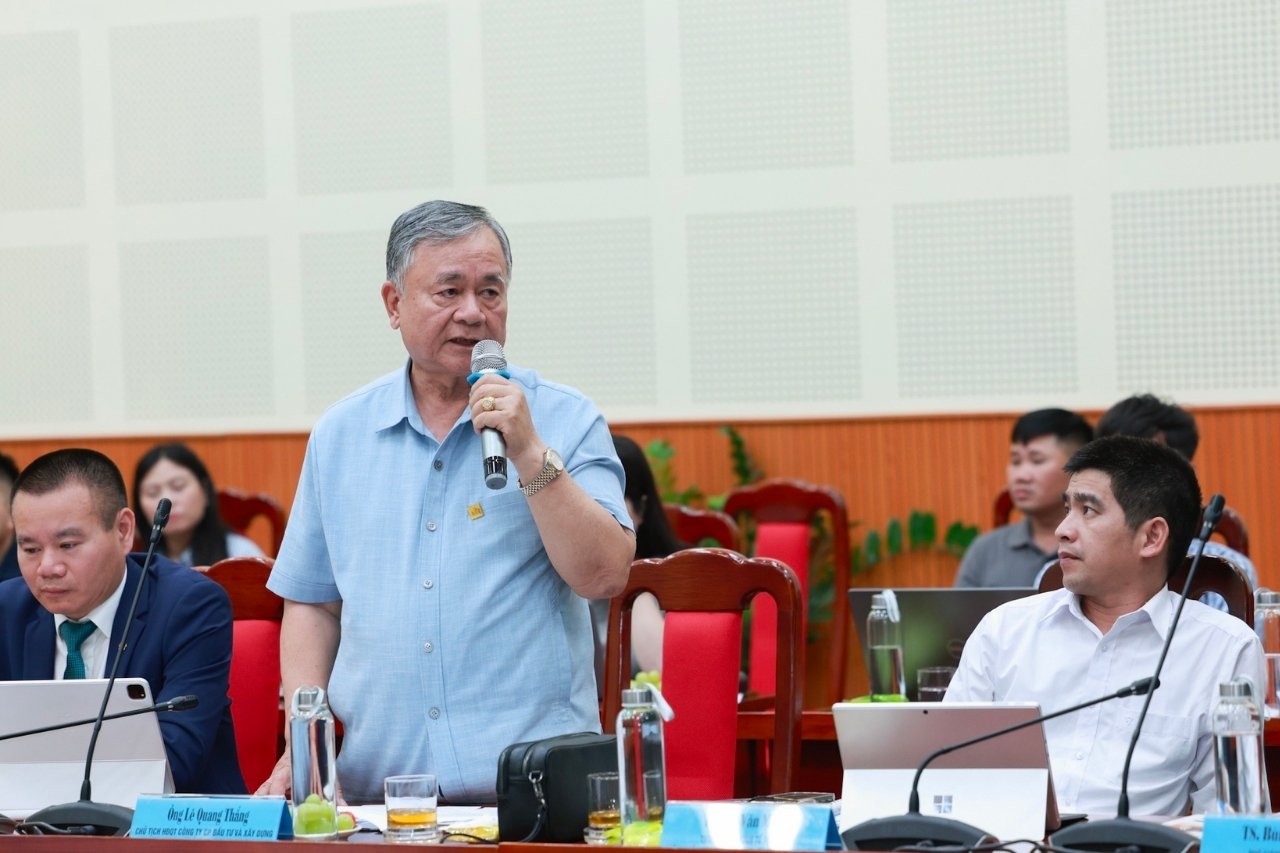
In particular, the Vegetable - Vegetable Processing Factory will be deployed into long-term products, or for special subjects such as: nutritional flour packages from vegetables, tablets... to ensure sustainable agricultural production, so that farmers are not afraid of not being able to consume the products they produce, or afraid of the crop losing value.
During the process of construction and establishment, the company has encountered many difficulties in accessing resources, especially access to credit sources, so we suggest that the State and State Bank have specific policies for green economic development, and must have green credit for the development of the country:
Green credit is considered an inevitable direction to promote sustainable growth, but according to my awareness, up to now, green credit in Vietnam is still very low compared to expectations (if it is green credit, it accounts for only 4.5% of the total outstanding loans of the economy).
For a business, accessing green capital is almost too far away, manifested in the following problems:
The bank may not be able to include businesses in the "Green" portfolio because there are no green criteria for each industry and field, so when working with the bank, we cannot access preferential capital. Specifically, the construction of our waste treatment and circular agricultural production factory has been approached by many banks for more than 10 years, which has taken a lot of effort to complete, but we still cannot access "green credit" capital.
Assets are guaranteed to be limited, unable to access credit capital, let alone green credit even though green projects require large investments, long capital recovery times: In agricultural production, we do not have traditional mortgaged assets, cannot use project-formed assets to mortgage loans, but often have to use assets other than the project to secure loans.
The risks and financial efficiency of the green economy are not attractive, so the Bank is not interested in green projects.
I have some suggestions as follows:
Proposing that the state have specific regulations on green projects for each industry and field, the SBV and commercial banks consider having better credit policies and interest rates for green enterprises.
Access and conditions for borrowing cheap capital from Fund sources and sources from international organizations still face many difficulties. Propose that ministries, SBVs, and commercial banks increase access to preferential capital for the Green Credit sector from international financial institutions, green credit funds, etc. to provide cheap green credit capital for businesses to operate more effectively, speed up the approval process and reduce conditions for businesses to access this capital source.
In case the project has unfortunate revenue that is not according to the plan, the bank should not put the problem of debt cancellation first, but may have solutions to restructure capital sources to extend debt repayment time so that businesses have conditions to recover and develop.
Need for more recommendations related to carbon credits
15:35: Dr. Bui Thanh Minh, Deputy Professional Director, Office of the Private Economic Development Research Board (Board IV) presented a paper on the topic " Private economy and green credit problem in the journey of sustainable development"
Dr. Bui Thanh Minh, Deputy Director of the Office of the Private Economic Development Research Board, shared: "From businesses, policy makers to businesses, everyone is waiting for a green portfolio, recommendations related to carbon credits, which need to be issued quickly so that everyone in the industry has a common language to communicate with each other".
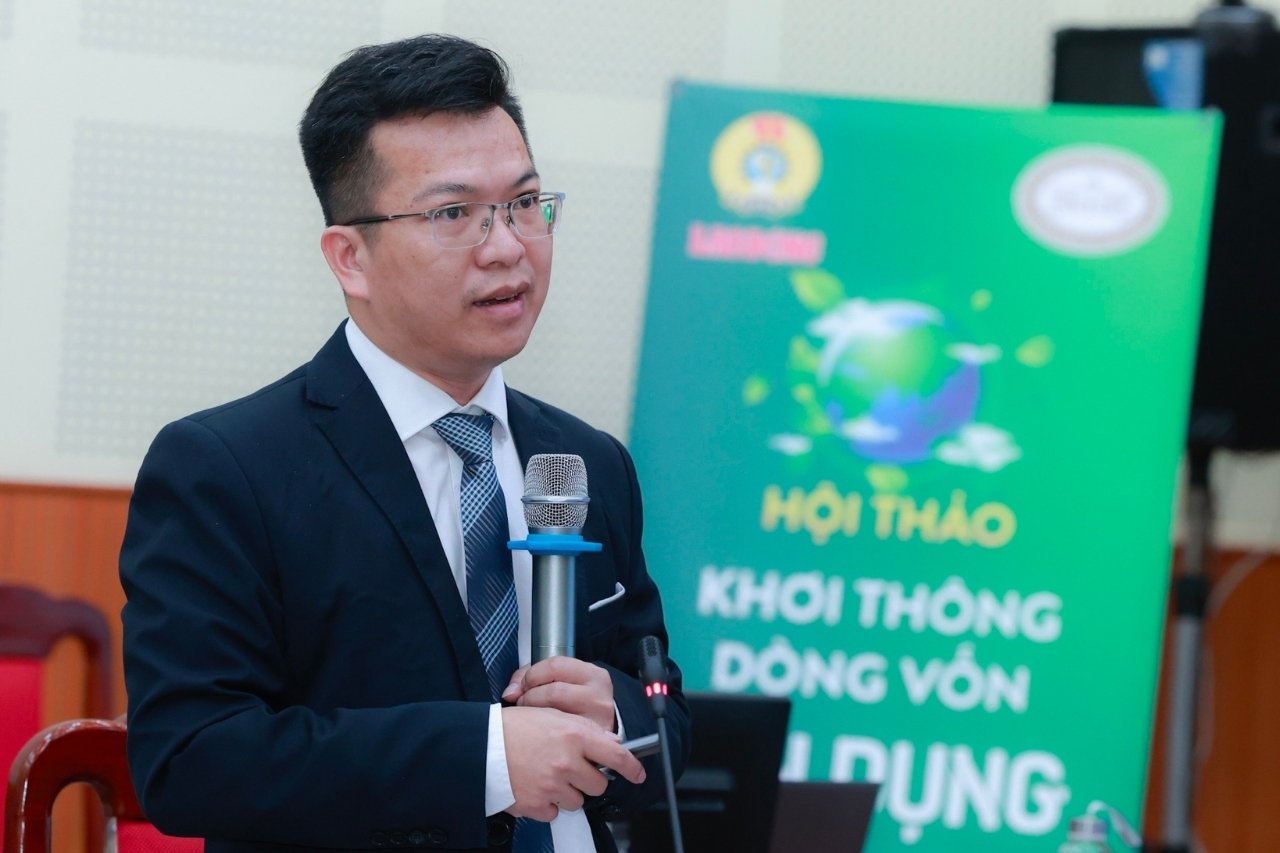
Green conversion is becoming a "race" at a global level when looking to large markets such as the EU, the United States, China, ... The most recent developments from Trump 2.0 have affected the green transformation, making the global concern about the US withdrawal from the global commitment of climate. The declaration and implementation have encountered barriers, but the long -term trend of the world still had to follow the common green path.
Or for China, this country commits to peaking emissions before 2030 and reaching carbon neutrality before 2060, also known as the "30-60" target or "double carbon target". The two documents "Ministry of Roadmaps for Peak Emissions and carbon Neutralness in the full and accurate implementation of the New Development philosophy" and "Action Plan to Peak Emissions Before 2023" have formed a China's "1+N" policy framework to achieve the 30-60 target.
Sharing at the seminar, Deputy Director of Professional, Office of the Private Economic Development Research Board (Board IV) added: "Vietnam needs to participate with determination and efforts commensurate with the strong commitment of the Government and the Prime Minister at COP26, COP27, COP28 to affirm the nation's pioneering as well as to effectively enlist international resources in the context of green conversion."
In addition, green transformation is not simply a single set of policies but includes a system of policies and a design of policy implementation programs to transform from investment, trade, development of economic sectors, promoting green initiatives... to activities to reduce emissions in practice.
Conducting surveys every year, Mr. Minh realized that there is an increase in business awareness. However, most businesses are only at the level of interest or have initial orientation. Up to 64% of enterprises have not yet taken any green transformation action, while only about 5.5% of enterprises have cut emissions in some activities and 3.8% have monitored and announced emission reduction results. This figure shows that most businesses are still in the preparation stage, not moving to planning or implementing specific green solutions.
Regarding the motivation to promote green transformation, the survey shows that internal factors play an important role. 51.9% of businesses said that green transformation helps optimize operational efficiency, while 36.7% said they are under pressure from customers and partners in the supply chain. However, new financial opportunities such as generating revenue from carbon credits or accessing preferential credit have not been fully identified: only 22.7% of businesses see this as an important driving force. This shows that market tools have not been exploited effectively, partly reflecting the limitations in information and technical capacity of businesses as well as the urgent need to increase the role of the above tools.
Regarding barriers, the survey results show that the lack of investment capital is the biggest challenge, 50% of businesses choose. Next is the lack of appropriate technical personnel (46%) and lack of green technology solutions (42%). In addition, many small and medium -sized businesses have difficulty accessing information, technical records and requirements from the bank, making it difficult for them to meet the criteria for access to green credit. The capacity to build and manage the green conversion project is still weak, especially in the areas that require high technology or strict waste emission certification process. The internal resources of private enterprises are not solid in the context of conversion pressure will create double difficulties for businesses. According to the White Book of enterprises in 2024, in 2022, 47.1% of private enterprises have a loss of business results among more than 710,000 businesses operating.
Once again, talking about the definition of green credit means that we are discussing the story of green transformation, how to make us have a green field. Green credit is like a clean water, can nurture us, creating real value sources. First of all, we must understand what green transformation is, green transformation is not a single policy but a comprehensive policy, from agricultural policy, finance, finance, credit, carbon credits, we must build such a system.
Second, we must clearly understand that green credit is not a cheap source of capital, but an old capital flow. Because when we switch to growth models that integrate multiple layers of capital sources, green credit must be a long-term capital source.
Vietnam's economic growth currently depends heavily on credit, credit growth is 14-15%, and you can sell it for 16-18%. Therefore, we need to discuss more carefully in addition to green transformation to get long-term capital for the economy. Many businesses have been in crisis when using short-term capital for long-term goals.
Regarding the readiness to implement green credit, Mr. Minh assessed that the banking industry has the highest readiness. Most businesses have paid attention, but sometimes they still have to worry about food, money, and economic stories. Or the story of policy conversion, commercial banks have professional design programs, issuing internal risk regulations. Not only providing green credit loan packages, but commercial banks are the best places to implement ESG.
Regarding the challenges that the parties are facing, Mr. Minh pointed out the following problems:
(i) Lack of a unified green taxonomy system for the entire financial system; (ii) There is no clear financial incentive mechanism for taxes, fees, and risk guarantees for both borrowers and lenders; (iii) The ability of businesses, especially small and medium enterprises (SMEs), to absorb green capital is still limited due to weak governance capacity, lack of guaranteed assets and imprecise financial records; (iv) Bank medium and long-term capital sources are still under pressure on mobilization terms, causing credit institutions to be cautious in expanding green credit portfolios.
Faced with the above challenges, the Office of the Private Economic Development Research Board (Board IV) offers a number of solutions:
Completing the legal framework and preferential policies
First of all, it is necessary to continue to improve the legal framework for green finance in general and green credit in particular. The Government and the State Bank should soon issue an official list of green projects eligible for credit priority, in order to create a clear legal basis for credit institutions to apply consistently. In addition, it is necessary to develop reporting and evaluation standards for green credit, such as requiring banks to periodically announce green credit balance and assess the emission reduction impact from lending portfolios. This standardization process not only helps to make information transparent but also strengthens market confidence in green financial products.
In terms of incentives, the State needs to design specific financial support policies to encourage credit institutions to expand their green lending portfolio. One of the solutions that can be applied is a preferential refinancing mechanism reserved for green credit, accordingly, the State Bank re-lends a part of the green loans that commercial banks have disbursed at lower interest rates, helping to reduce capital costs for lenders. In addition, establishing a green credit guarantee fund or expanding the guarantee scope of the Vietnam Environmental Protection Fund for bank loans is also a feasible direction to share credit risks. However, it is necessary to study preferential tax policies, including corporate income tax or green equipment import tax, for banks and businesses that actively participate in green credit programs.
Strengthening green financial capacity and international cooperation
Improve the professional capacity of credit institutions in appraising, managing and developing green credit products. Banks need to be trained in the method of assessing environmental - social risks, building environmentally effective metering tools of the project such as CO2 emission reduction or energy saving. The establishment of a specialized unit on sustainable development and green credit within the bank will contribute to the professionalization of this activity.
In addition to domestic efforts, international cooperation plays an essential role in expanding resources and implementation experience. Vietnam can learn from countries that have gone before such as China with the Green Credit Guidelines issued in 2012, while actively mobilizing preferential capital sources from international financial institutions such as the World Bank, the Asian Development Bank, and the Green Climate Fund. Participating in public-private cooperation programs in the fields of renewable energy and sustainable infrastructure will also contribute to promoting technology transfer and attracting foreign investment.
Diversifying green financial instruments
In addition to credit, it is necessary to diversify green financial instruments to create a more complete and sustainable green financial ecosystem. Solutions such as developing the domestic green bond market, building a carbon credit trading floor, implementing climate risk insurance, or encouraging businesses to issue green bonds and establish green investment funds will help reduce pressure on the banking system, while creating conditions for businesses to mobilize capital more proactively.
Supporting private enterprises to transform green
Finally, there should be specific solutions to support private enterprises in improving their capacity to access and use green credit.
Challenges
15: 15:5: Presenting part of Mr. Nguyen Ba Hung, Chief Economist in Vietnam, Asian Development Bank (ADB):
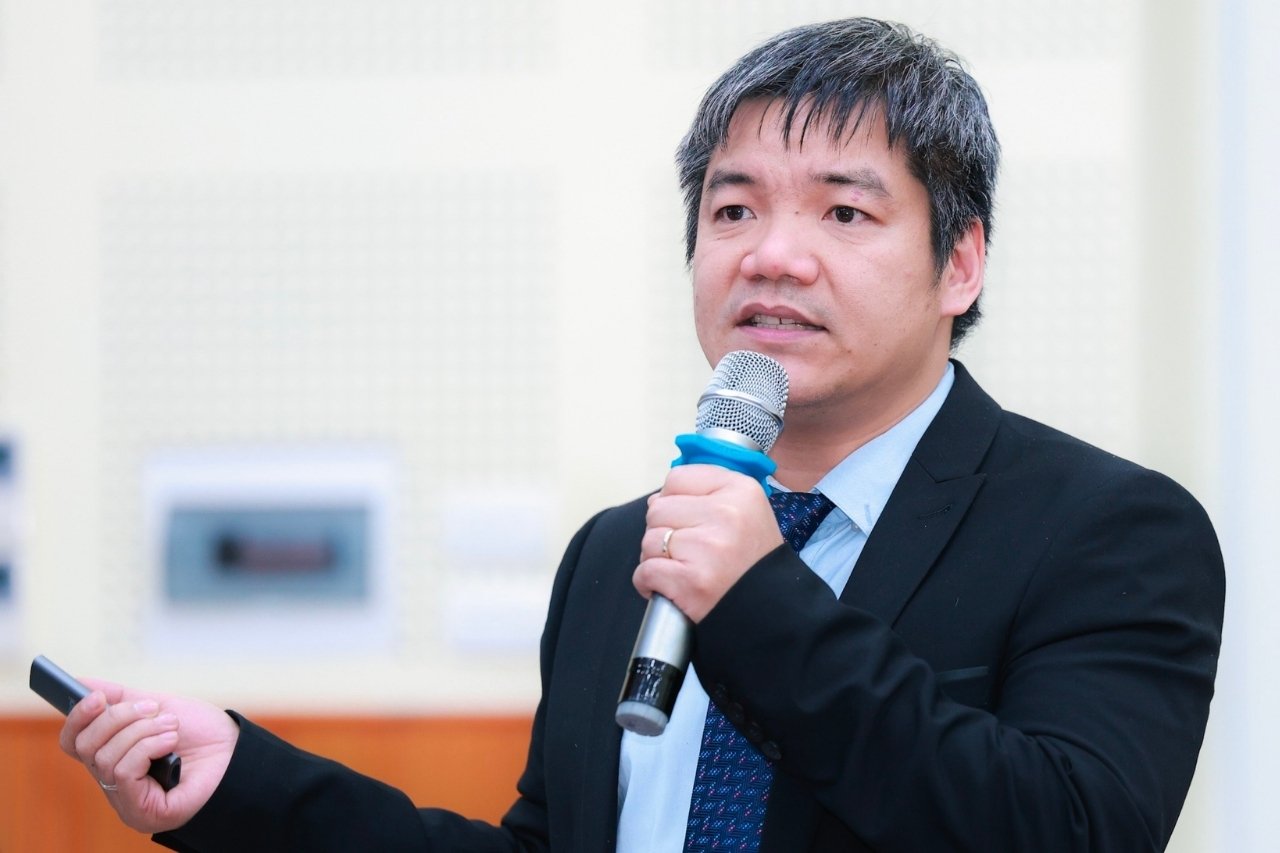
According to Mr. Nguyen Ba Hung, now the concept of green financial has many, sometimes inconsistent. Green finance must come from finance, in addition to adding some concepts related to the environment and climate (reducing CO2 emissions, adapting to climate change). Next is the social factor related to gender or the benefits of groups related to social difficulties. Sustainable criteria combine green and social, management factors tend to be wider in ESG. Next is energy shift, businesses prioritize reducing emissions, towards reducing emissions by zero. Therefore, businesses can switch to intermediate energy forms, although it is still a fossil energy but has a lower rate. This is not the destination but the energy transition.
Assessing the green financial market, Mr. Nguyen Ba Hung said that each subject plays a different important role. A very important subject is finance - banks and financial institutions, but the green factor is still new. Previously, when finance had not discussed the green factor, most credit institutions considered the ability of businesses to do business effectively and repay debts. The difference between green finance and regular finance is that credit institutions (CIs) must know what credit is used for and whether the activities meet green standards or not. This is a new factor for credit institutions. The production activities of enterprises themselves must be green and enterprises must prove this based on general criteria and conditions.
20 years ago, Vietnam's emissions/GDP ratio was the lowest in the region. However, in recent years, Vietnam has been among the highest countries in the region. This shows that our time of industrialization is increasing very rapidly. However, the industrialization process uses more energy emissions, leading to an increase in emissions/GDP units. Meanwhile, other countries in the region are showing a downward trend.
For emissions/energy consumption units, about 20 years ago, Vietnam was also the lowest in the region. However, in recent years, it has been one of the highest rising countries in the region. Vietnam is in the upward trend, countries in the region are tending to decrease. Green conversion in Vietnam is not subjective wishes but has become an objective requirement ” - Mr. Nguyen Ba Hung emphasized.
More information about the green financial market in the world, Mr. Nguyen Ba Hung said - Green financial market has many different products such as green credit, green bonds, social loans, sustainable loans ... The first time of green finance in the world mainly goes from green bonds. However, recently, green credit products have caught up with green bonds.
Europe is still a leading region in green finance. Next is Asia Pacific. ASEAN+3 countries have tended to grow green finance in recent years very dynamically, higher than the world average growth rate.
Countries in the ASEAN+3 region have issued a relatively legal framework on green finance, but Vietnam has not yet issued it. Financial institutions around the world have 2 different ESG assessment frameworks. From a market perspective, when looking at the green financial and sustainable finance markets, they clearly assess the financial and green aspects. Assessing financial credit is easy because there are clear profit and debt collection assessment indicators. However, in the green and sustainable part, organizations are also gradually introducing ESG assessment indicators for assessment" - Mr. Hung said.
According to Mr. Nguyen Ba Hung, green finance is an inevitable development trend, not only an option but an urgent requirement to ensure a sustainable future. The green finance market in the world is very vibrant. Surrounding countries have also gradually introduced measures to assess green finance. This transformation is driven by the combination of economic, social and environmental factors, creating a strong driving force for restructuring the global financial system.
Mr. Hung said that Vietnam needs to unify how to be green and what does green transformation mean. Outstanding green credit last year accounted for 4%, this is not a large number but the increase trend is relatively steady, it is expected to increase faster. In addition to this green credit, there is also 21% of total outstanding loans with an ESG risk assessment. Vietnam's credit institutions have gradually assessed production and business activities as contributing to the environment and society of enterprises.
In the coming time, Vietnam needs to complete the legal framework for green credit and improve the capacity of financial institutions. Raising awareness and participation of businesses and people. Credit institutions cannot decide whether a green project is or not, so businesses must prove that they are green. Vietnam needs to continue to attract and exploit international green capital. In the country, investors do not focus much on green, while the world has a lot. Finally, it is necessary to prioritize key areas and risk management" - Mr. Hung recommended.
Breakthrough in legal foundation for green credit
14:52: Presentation by Dr. Lai Van Manh - Institute of Strategy and Policy on Agriculture and Environment (Ministry of Agriculture and Environment):
We have worked with the Ministry of Finance and the State Bank to send the Green Classification List to the Government. This is an important step to complete the legal framework for the green financial market ” - Dr. Lai Van Manh shared. He emphasized:" For the first time, the Law on Environmental Protection has made a breakthrough step when included in two separate terms of green credit and green bonds - creating a legal foundation for mobilizing and allocation of capital flows for sustainable development goals. "
The 2020 Law on Environmental Protection clearly stipulates for the first time green credit in Article 149 and green bonds in Article 150. Next, Decree 08/2022/ND-CP has specified the roadmap and incentive mechanisms for these two financial instruments in Articles 154, 155, 156 and 157. Currently, the Ministry of Natural Resources and Environment is developing and submitting to the Government a Green Classification List - acting as a set of technical criteria as a basis for granting green credit and issuing green bonds.
From the perspective of environmental law, this is a fairly complete legal basis for the implementation of green credit and green bonds. In addition, specialized legal documents on credit and bonds also have unified regulations for these two tools. Thus, the current legal framework is relatively comprehensive. For the market to operate effectively, it is still necessary to continue to improve the organizational system, policies and coordination mechanisms between relevant parties.
However, green credit (TDX), green bonds (TPX) and green classification portfolios are all new issues in the world and in Vietnam, each different country will have differences in institutions, policies, laws, environmental goals, climate change response goals ... leading to different approaches, structures and specific requirements for the Green Classification List. Based on experience and international practice, the article proposes an approach and roadmap for the Green classification List (PLX) in Vietnam.

There are currently a number of different viewpoints and approaches to the Classification List such as the sustainability classification list, the green classification list, the climate classification list, etc.
In short, the PLX portfolio is a portfolio of projects with environmental protection goals or environmental benefits granted by the TDX, issued with green bonds in conjunction with specific technical criteria and requirements to ensure environmental protection goals and respond to climate change. The PLX List is an important pillar of the Sustainable Classification List.
Each country has different institutions, policies, laws, management levels, goals, requirements and regulations on the environment and climate. Therefore, detailing specific PLX Lists will facilitate the application, directly contributing to the environmental and climate goals, requirements and regulations of that country.
To date, there are about 35 types of classification categories that have been published or are in the process of being completed in different forms such as: classification framework
types, instructions or legal regulations. In which, the portfolios of the EU, China, and ASEAN are considered the most comprehensive.
All PLX Lists are built with the common purpose of helping financial institutions, investors, state management agencies, policy-making agencies and stakeholders determine which investments can be labeled as green, thereby helping to make decisions on environmentally friendly investments, encourage and expand the implementation of projects and sustainable economic activities with the environment and contribute to specific environmental goals. There are differences in the specific environmental goals of each PLX List to demonstrate the national environmental goals and the priority level for the development of economic sectors that countries are aiming for.
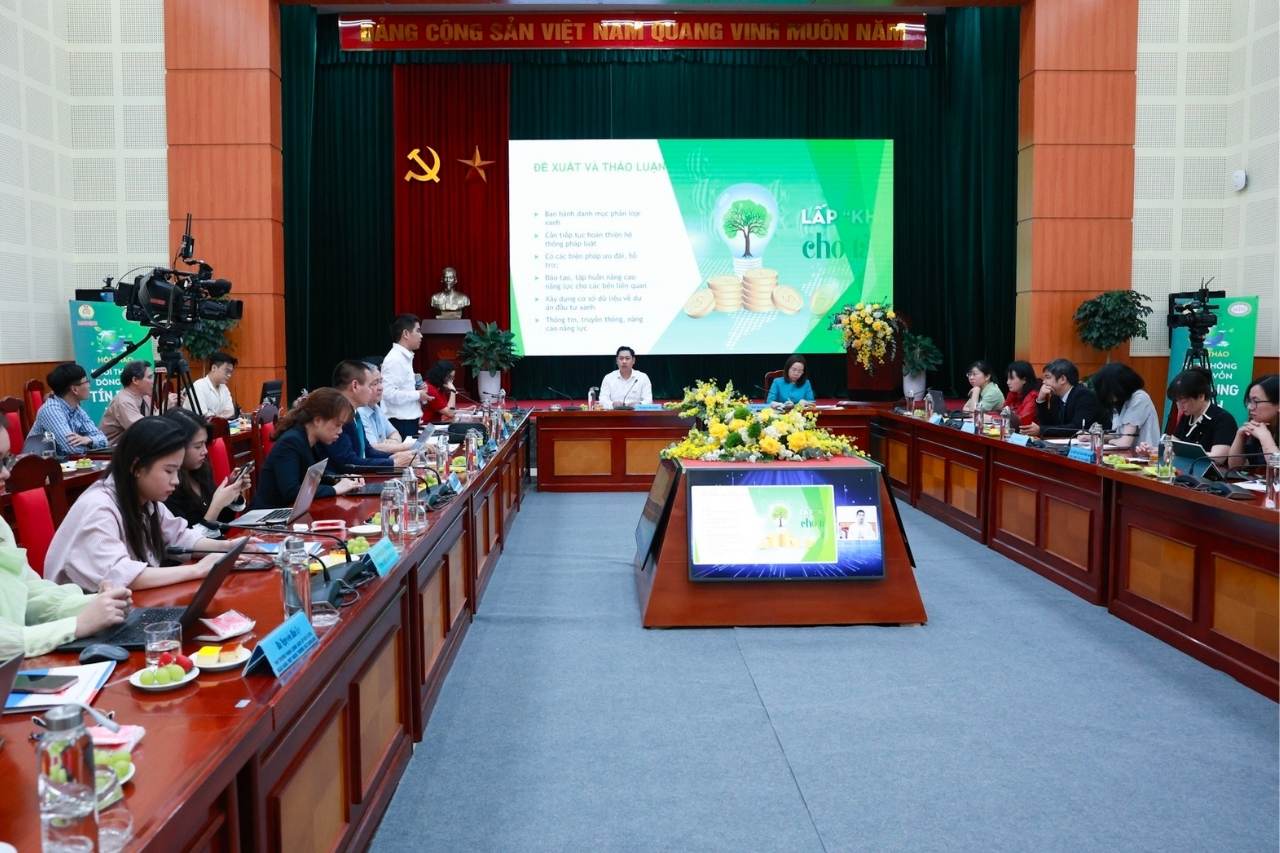
In general, the most popular PLX portfolios in the world today are still approached mainly based on the following 3 main principles:
Approach according to the principle of "White List": This approach focuses on determining eligible projects or economic activities for each industry or sub-sector. This classification lists technologies that are considered green or sustainable and provides a detailed description of eligibility. This approach was used by Russia, China and ancient Mongolia in the process of building their PLX List.
Approach based on Technical screening criteria: This approach provides information on screening thresholds and criteria for economic activities and their compliance with specific goals. Accordingly, these categories identify each economic activity as having at least one significant contribution to environmental and climate goals and at the same time ensure that it does not cause significant harm to other environmental goals. This approach is reflected in the PLX portfolios of Korea, the EU and South Africa.
The Principles-based approach (principles-based approach): similar to ICMA's Green Bond Principles, this approach is applied in the Classification List of Malaysia and Japan. This green list of approaches will include core guidelines for assessing which economic activities may be funded.
Dr. Lai Van Manh recommends the fields and types of investment projects in the list of green classification for green credit and green finance in Vietnam:
In the energy sector, including solar power projects, wind power, other renewable and clean energy sources such as geothermal, thermal power, tidal, waves, collisions, waste, green hydrogen, green am ammonia, along with works, equipment, and technology for transmission, storage, and release of renewable energy sources.
In the field of transportation, it is recommended that transportation projects use vehicles that do not emit or emit low carbon, infrastructure and energy recharge services for vehicles that do not emit or contain low carbon.
For the construction sector, including projects to build new or renovate houses and public works to meet green, environmentally friendly project standards, using energy effectively.
The water resources sector includes projects to build water supply and drainage works, exploitation - treatment - supply of clean water and management and protection of water resources.
In the fields of agriculture, forestry, fishery and biodiversity conservation, the list includes projects for cultivation according to VietGAP, GlobalGAP, and circular standards; safe livestock farming; afforestation, combined forestry and forestry farming; sustainable aquaculture; sustainable food production - processing; eco-tourism; protein conservation and rare species; sustainable farming on land at risk of degradation; treatment and improvement of soil resources; and activities of collecting, treating, recycling agricultural - forestry - fishery waste.
The processing and manufacturing sector includes projects to produce energy-saving equipment and machinery; electronic components for low-carbon technology; packaging and environmentally friendly chemicals; as well as technology and equipment for environmental protection.
Finally, in the field of environmental services, it is recommended that projects for collection, classification, transportation, and treatment of solid waste (active and industrial waste), hazardous waste, urban wastewater and production and treatment of emissions.
Regarding the environmental criteria for investment projects to be granted TDX, the issuance of green bonds is the criteria for adjusting the design, performance, materials, production, maintenance and change or modification of products, goods or services to ensure production processes, products, goods or services that meet environmental protection goals, including: screening criteria, environmental indicators and other environmental objectives. In particular, the requirements do not significantly harm other environmental goals including: Suitable for environmental protection planning, provincial planning, standards and local environmental technical regulations; Comply with environmental impact assessment requirements, environmental licenses and other requirements in accordance with the law on environmental protection.
Regarding the confirmation of investment projects on the PLX List, it is advisable to approach based on international experience, diversify the forms of confirmation such as self-confirmation or confirmation through qualified consulting units. In case it is necessary to implement the State's policies related to green credit, green bonds and green finance (such as incentives and support), it is necessary to promote the role of independent organizations with sufficient capacity and in accordance with Vietnamese laws to carry out confirmation and assessment. The proposed confirmation approach also promotes the autonomy and decision-making rights of financial institutions, ensuring safety, control and compliance with international practices.
In short, building a PLX List system according to international standards plays a very important role for Vietnam in promoting sustainable development and sustainable development and environmental protection. Applying international standards in evaluating and classifying green projects will bring many significant benefits to the country, from economic, environmental to social aspects.
One of the top priorities is to facilitate sustainable development. The development of PLX based on international standards helps to clearly identify important criteria and factors in assessing the sustainability of projects. This encourages investment and development of projects with a positive impact on the environment, while limiting the development of harmful projects.
Green growth - the main development trend in the world
14:40: Ms. Ha Thu Giang - Director of the Department of Credit for Economic Sectors - State Bank of Vietnam:
Green growth and sustainable development continue to be the main development trend in the world against increasingly serious issues of environmental pollution and climate change. Being aware of the challenges and requirements for socio -economic development in the new context, the Party and the State have proposed views, orientations and goals on environmental protection and sustainable development of the country. At the same time, building and implementing overall solutions to effectively mobilize capital from all areas for green economic transformation, reducing greenhouse gas emissions.
In addition to public investment capital, in the context of the developing and emerging green bond market and carbon market, green credit capital of the banking system has been playing an important role in promoting activities that bring environmental benefits, developing sustainable production models, contributing to the transformation of a green, low-emission economy. In recent times, the SBV has been implemented promptly, creating conditions for green credit activities to be promoted and developed. Specifically:

Firstly, the SBV has operated a reasonable credit policy, meeting the credit capital needs of the economy to support economic growth, directing credit to priority areas and economic growth drivers according to the Government's policy, including supporting the economy to switch to a green growth model.
Second, orient the goal, develop solutions to promote and develop green credit and green banking to contribute to the transformation of the economy to green, low carbon emissions; increase the proportion of bank credit capital invested in renewable energy, clean energy, manufacturing and consumption sectors with low carbon in the Banking Industry Development Strategy to 2025, Green Banking Development Project in Vietnam, Project to restructure the system of credit institutions associated with bad debt handling in the period of 2021 - 2025...
Third, the SBV reviews, amends and completes legal regulations on credit granting activities of credit institutions (CIs) to customers to create unity, synchronization and compliance with the trend of green growth and sustainable development. Specifically:
Review and amend regulations related to credit, supplement credit granting methods.
At the same time, issue Circular No. 17/2022/TT-NHNN guiding credit institutions to implement environmental risk management in credit granting activities according to the provisions of the Law on Environmental Protection (2020).
Fourth, actively implement credit policies to focus capital on green industries/sectors, agricultural production according to the linkage model, applying high technology, policy credit programs to support the poor in housing to prevent climate change...
In particular, in 2024, the SBV coordinated with the Ministry of Agriculture and Rural Development (now the Ministry of Agriculture and Environment), 13 provinces in the Mekong Delta, to direct credit institutions to implement the Project "Sustainable development of one million hectares of high-quality and low-emission rice cultivation associated with green growth in the Mekong Delta by 2030" according to Decision 1490/QD-TTg dated November 27, 2024 of the Prime Minister.
In addition, the SBV has also actively participated as a member of many international financial forums to learn from experience, mobilize resources, improve capacity... in promoting green credit and green banking activities for green and sustainable growth goals; at the same time, based on the actual implementation of Vietnam, it has also contributed many initiatives on green banking, gradually enhancing Vietnam's position at international forums and organizations on banking currency, serving the development of the banking industry, in line with the requirements of international integration.
On the side of credit institutions, credit institutions have actively implemented tasks and solutions to achieve the green credit goals, the green bank is quite comprehensive, meeting the regulations of the State Bank, the provisions of the law on the environment, the shop needs to be conducted with international standards. The credit institutions actively promulgate and integrate the contents of green growth in business development strategies and plans; Diversify resources (including: Green deposit products, Green bond issuance, access to capital of funds and international financial institutions) for green growth in addition to traditional mobilized capital; proactively research and develop green credit products, modern products and services, new payment means; establish a system and implement environmental and social risk management in credit activities; Strengthen training to improve the capacity of bank officials on ESG, Green Finance, Green Bank and Sustainable Development.
As a result, as of December 31, 2024, 48 credit institutions have provided loans with outstanding green credit reaching nearly VND 680 trillion, an increase of 9.5% compared to the end of 2023, mainly focusing on renewable energy, clean energy (accounting for more than 41%) and green agriculture (over 29%); the average growth rate of outstanding green credit reached more than 21.2%/year in the period 2017 - 2024, higher than the credit growth rate of the entire economy. To date, outstanding loans assessed for environmental and social risks have reached VND 3.6 million billion, an increase of over 26% compared to the end of 2023.
In addition to the positive results achieved, green credit activities also face some difficulties as follows:
The National Green Classification List, the Green Economic Sub-System with determinative and qualitative environmental criteria have not been issued, serving as a basis for determining and classifying economic activities, causing difficulties for the banking system in implementing and fully compiling credit resources for green growth and environmental protection goals.
Institutions, investment policies for green growth, and support mechanisms for green transformation are in the process of being built and completed.
Mobilizing investment capital for projects, green domestic sectors and international markets is still facing difficulties due to the impact of political economic instability, interest rate-related issues, exchange rate risks, etc.
Investing in green projects requires large capital sources and the ability to assess specialized environmental technical factors, so credit institutions will incur additional investment costs to build a governance system in line with the goals of green growth, green transformation of the economy, and improve the capacity of banking staff in green banking and sustainable finance.
The awareness of businesses and investors about the benefits and importance of the green financial market is not uniform, leading to the level of interest of customers in mobilization products and green financial credit products not being high, and the fear of using new banking products/service.
The information system on customers' compliance with environmental protection is still limited and difficult to access with credit institutions, leading to difficulties in the process of exploiting, collecting and processing information for environmental risk assessment, as well as in the process of auditing and monitoring.
In the coming time, on the basis of closely following the goals on socio -economic development, the National Strategy for Green growth and the assigned tasks in the Scheme, Strategy, Action Plan on Green growth, anti -climate change, the Prime Minister's Directive on promoting the implementation of the National Strategy on Green growth, the State Bank continues to deploy the National Banking and Green Banking Groups on the National Banking Plan on the National Bank of Banking and Green Bank. 2021 - 2030, which focuses on key solutions:
Continue to operate monetary policy proactively, flexibly, promptly and effectively, coordinate synchronously, harmoniously and closely with fiscal policy and other macroeconomic policies, contributing to promoting economic growth, stabilizing the macro economy, and controlling inflation. In recent Government guidelines, green growth is one of the new growth drivers, therefore, promoting solutions in general as well as promoting the application in particular will support green growth industries. Thereby, contributing to the minimum economic growth target of 8% in 2025.
Continue to review and improve the legal framework on green credit and green banking; support credit institutions in implementing environmental and social risk management policies, increase the mobilization of international resources to finance green projects, including proposing amendments and supplements to mechanisms and preferential credit policies to encourage the development of high-tech agriculture, organic agriculture, and agriculture according to the circular economy model.
Guiding credit institutions to provide credit for projects with environmental benefits and environmental protection after the National Green List is issued.
Actively connect with domestic and foreign organizations to receive financial support, technical assistance to implement green finance and green banking activities, especially improving the capacity of banking staff on banking - green credit, climate change.
Strengthen information and propaganda work in the banking industry to raise awareness and understanding for bank staff and customers about green growth, sustainable production and consumption.
To achieve the above goals, stemming from the above practical requirements, to expand, unlock and effectively use green credit capital of the banking system, it requires coordination and combination from ministries, branches and competent authorities in perfecting the legal corridor, support mechanisms, creating motivation to mobilize all resources from economic regions, specifically the following recommendations and proposals:
Ministries and branches continue to pay attention to investment and investment to create a favorable investment environment; develop a roadmap to implement policies and mechanisms to support green sectors (taxes, fees, capital, engineering, markets, to planning, development strategies...) of each sector/sector in a synchronous manner to attract and promote the effectiveness of green credit capital.
The National Green Classification List will be issued soon; complete the legal framework for green financial instruments such as green bonds, develop markets for exchanging emission rights; complete tax tools for activities with carbon emissions.
Develop and implement solutions to support credit institutions in accessing and mobilizing financial resources from institutions, finance, funds and international private investors, financial funds to facilitate the provision of long-term credit and more suitable preferential interest rates for green sectors/sectors.
Vietnam has many favorable conditions and opportunities for green economic development
14:18: Mr. Dao Minh Tu - Permanent Deputy Governor of the State Bank of Vietnam delivered the opening speech at the Workshop
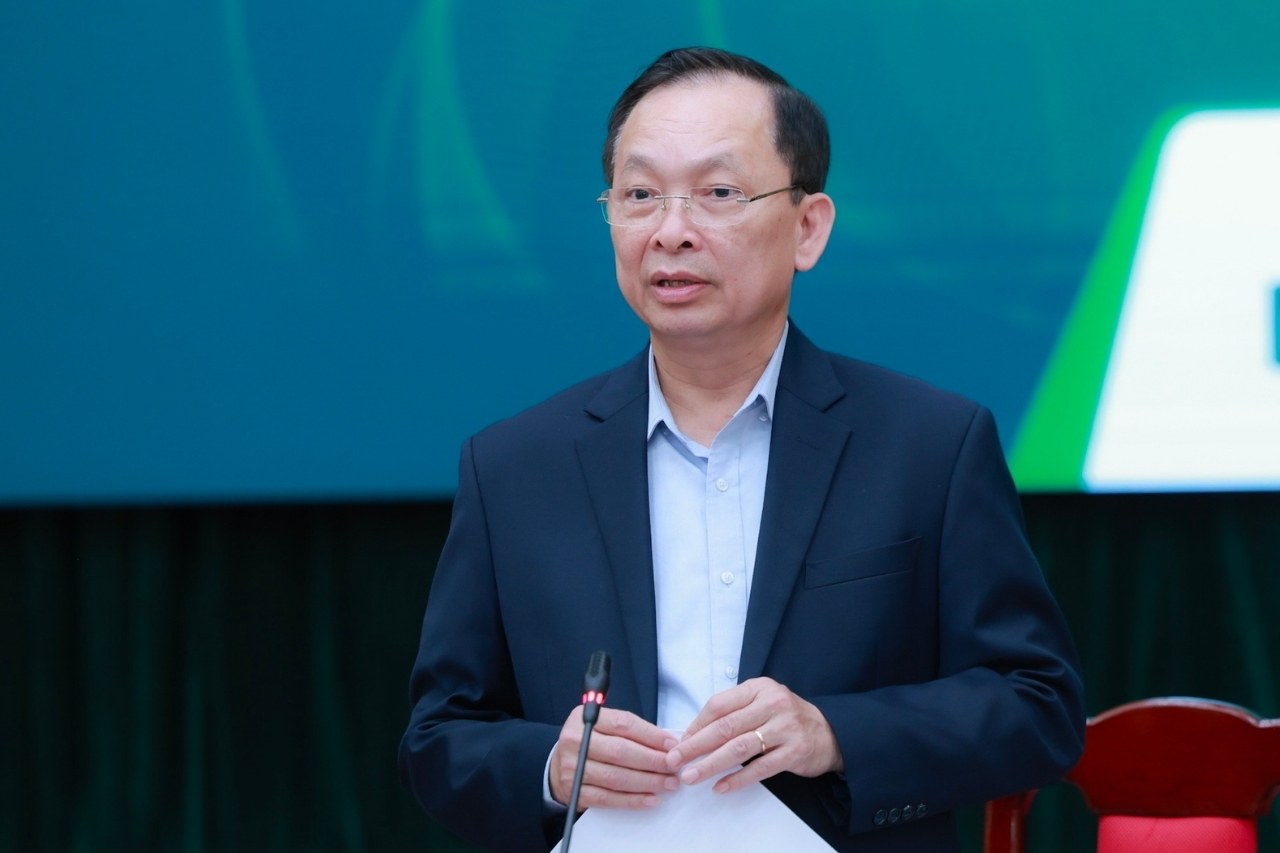
The Permanent Deputy Governor of the State Bank of Vietnam affirmed: Green finance, including green credit, is not a new issue but is receiving more and more attention from countries around the world as well as from Vietnam, especially in the current context of the need to promote the mobilization of resources to promote economic restructuring associated with growth model innovation, in order to achieve economic prosperity, environmental sustainability and social justice; towards a green, carbon-neutral economy and contributing to the goal of limiting global temperature increase.
Green credit and ESG implementation are an inevitable trend for sustainable development, one of the important resources to achieve the national green growth target, a solution to help credit institutions reorient their business activities towards sustainability, approaching international standards, thereby affirming their position, enhancing competitiveness, expanding cooperation and business opportunities; at the same time, for businesses, green credit is a resource to support businesses to improve technology, and transform green production.
Mr. Dao Minh Tu commented that Vietnam has many favorable conditions and opportunities for development, thanks to very clear orientations and regulations.
Firstly, the Law on Environmental Protection (2020) and guiding documents of the Law have stipulated green credit, a roadmap for developing green credit, support and encouragement measures for developing green credit, creating a legal corridor for green credit activities of the banking system.
Secondly, in the national green growth strategy through the recent stages and resolutions of the Government on socio-economic development, showing the determination of the Government and the Prime Minister in implementing "Green conversion-digital transformation", fast and sustainable development to achieve economic development goals of 2 digits of the period 2026-2030. In particular, the Government and the Prime Minister all put the tasks and requirements for the banking industry to promote green and green banks;
Thirdly, on the basis of these policy frameworks, over the past time, the banking sector has entered drastically, proactively and implemented solutions to promote green credit activities and have achieved many positive results on awareness, the number of credit institutions sponsor capital for green fields, scale and growth rate of green credit balance: From only 15 credit institutions participating in 2017, the amount of green debt has been grown. The period of 2017-2024 reached over 22%/year, the following year was higher than the previous year, higher than the growth rate of general credit balance for the economy. These figures are very encouraging, but the ratio of green credit to total new credit balance accounts for about 4.6%, showing that green credit in Vietnam still has a lot of rooms to develop. Set urgent requirements in accelerating and taking advantage of that room.
In practice, banks and businesses all face many difficulties such as: No National Green Classification List, general regulations on ESG for businesses to practice and meet increasingly strict sustainable development requirements; Risk assessment tools are still limited, long capital recovery time, unclear financial efficiency; Higher requirements for governance, quality of banking human resources in the fields of environment, society, and climate to identify, appraise, manage, monitor credit granting as well as consult and support customers to meet new international criteria on emissions (such as the carbon Border Adjustment Mechanism has been legalized as part of the European Green Agreement, fully implemented from January 1, 2026, accordingly, businesses subject to taxes when exporting bonds to these markets will not meet emission standards.
This is one of the challenges for Vietnam when this policy is set for all countries. Those bottlenecks require a new more comprehensive, flexible and synchronous approach between policies market legal corridor.
Today's workshop was held to create a space for connecting managers, experts, associations, credit institutions and businesses - where all parties can discuss frankly the difficulties in the practical implementation of green credit, share useful initiatives as well as make proposals to gradually improve mechanisms and policies. In that spirit, the Permanent Deputy Governor of the State Bank requested that the delegates representing State management agencies, domestic and foreign experts, enterprises, associations, and credit institutions focus on exchanging and discussing the following issues:
The role and contribution of green credit in sustainable financial development strategies and implementing solutions to mobilize resources to implement national green growth strategies. Because the story of green credit capital is a huge problem, current capital sources are short-term capital sources, while the requirement must be long-term capital sources.
Assessing the current situation and difficulties in implementing green credit in Vietnam in recent times. More than anyone else, commercial banks can evaluate the process and methods of providing capital to businesses. Banks themselves also recognize the problems seen from businesses and projects. So that both sides can boldly borrow and lend, they cannot hesitate.
International experience and solutions for credit institutions to promote green credit activities, as well as solutions for Vietnamese enterprises to access green credit more easily.
Finally, on behalf of the banking industry, I would like to thank Lao Dong Newspaper for organizing a very meaningful seminar, always a topical topic. Green transformation and green credit are areas that the Party, State, and Prime Minister are very interested in, associated with the environment and living environment.
Take the example of the 1 million ha project in the Mekong Delta - one of the typical projects for green credit. If there is synchronization in legality and awareness of businesses, banks, and farmers, this capital source will be effective. Obviously this is an environmental story associated with a green economy and green banking. From a macro perspective, we have a legal corridor, but looking at each specific project, we have clear evaluation criteria. This is an urgent issue that needs to be built more specifically.
The State Bank of Vietnam affirmed that the Workshop is an opportunity to listen to opinions and exchanges from experts, representatives of management agencies, research policies and businesses to have different perspectives on the implementation of green credit activities in the banking industry, the application of mechanisms and policies into practice. These will be contributions and suggestions for management agencies in planning policy mechanisms, as well as implementing green credit activities in practice of credit institutions, creating motivation to unblock credit flows in the banking sector for green goals and sustainable development.
Green credit - a catalyst to help businesses innovate production models
-14:15: Mr. Nguyen Ngoc Hien - Member of the Presidium of the Vietnam General Confederation of Labor, Editor-in-Chief of Lao Dong Newspaper - gave a speech.
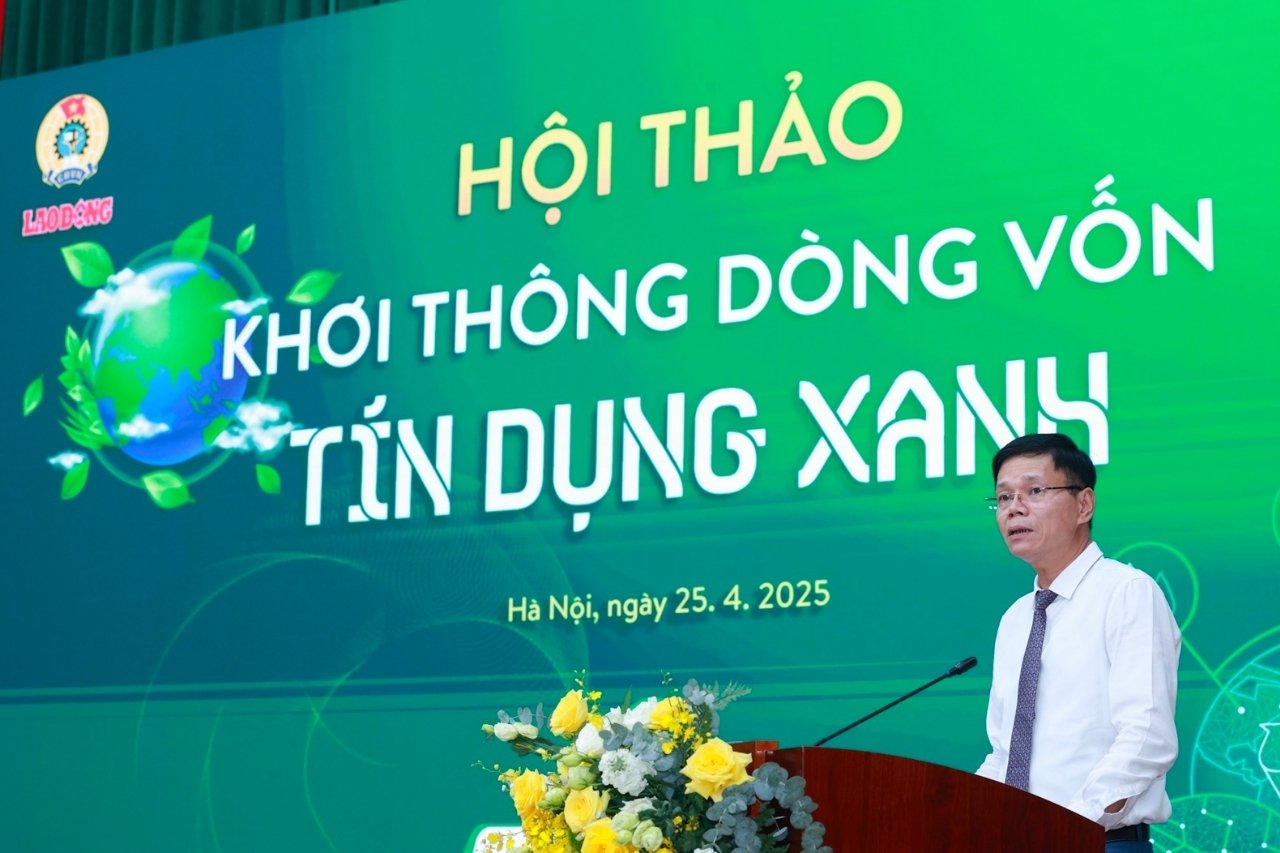
In his opening speech, Mr. Nguyen Ngoc Hien - Member of the Presidium of the Vietnam General Confederation of Labor, Editor-in-Chief of Lao Dong Newspaper said: "Green credit plays an important role in the sustainable financial development strategy. This is not only a capital flow to promote environmentally friendly projects, but also a catalyst to help businesses innovate production models, adapting to the increasingly clear green transformation trend".
Promoting green credit: Need for a comprehensive and synchronous approach According to data from the State Bank, if in 2017 there were only 15 credit institutions participating, by 2024, there were 48 units with outstanding green credit. These figures show that green credit in Vietnam still has a lot of room for stronger development.
The Editor-in-Chief of Lao Dong Newspaper said that during the operation process, banks and businesses still face many difficulties: lack of a unified criteria framework to identify green projects, limited risk assessment tools, long payback time, unclear financial efficiency... Those "bottlenecks" require a new - more comprehensive, more flexible and synchronous approach between policies, markets and the legal corridor.
On behalf of the Organizing Committee, Editor-in-Chief of Lao Dong Newspaper Nguyen Ngoc Hien sent his sincere thanks to the accompanying units and delegates attending the Workshop "Unblocking green credit flows" organized by Lao Dong Newspaper and the State Bank of Vietnam today.
Today's workshop was held to create a space for connecting managers, experts, credit institutions and businesses - where the parties can discuss frankly, share practical initiatives, thereby recommending solutions to gradually perfect mechanisms and policies to promote green credit development more effectively.
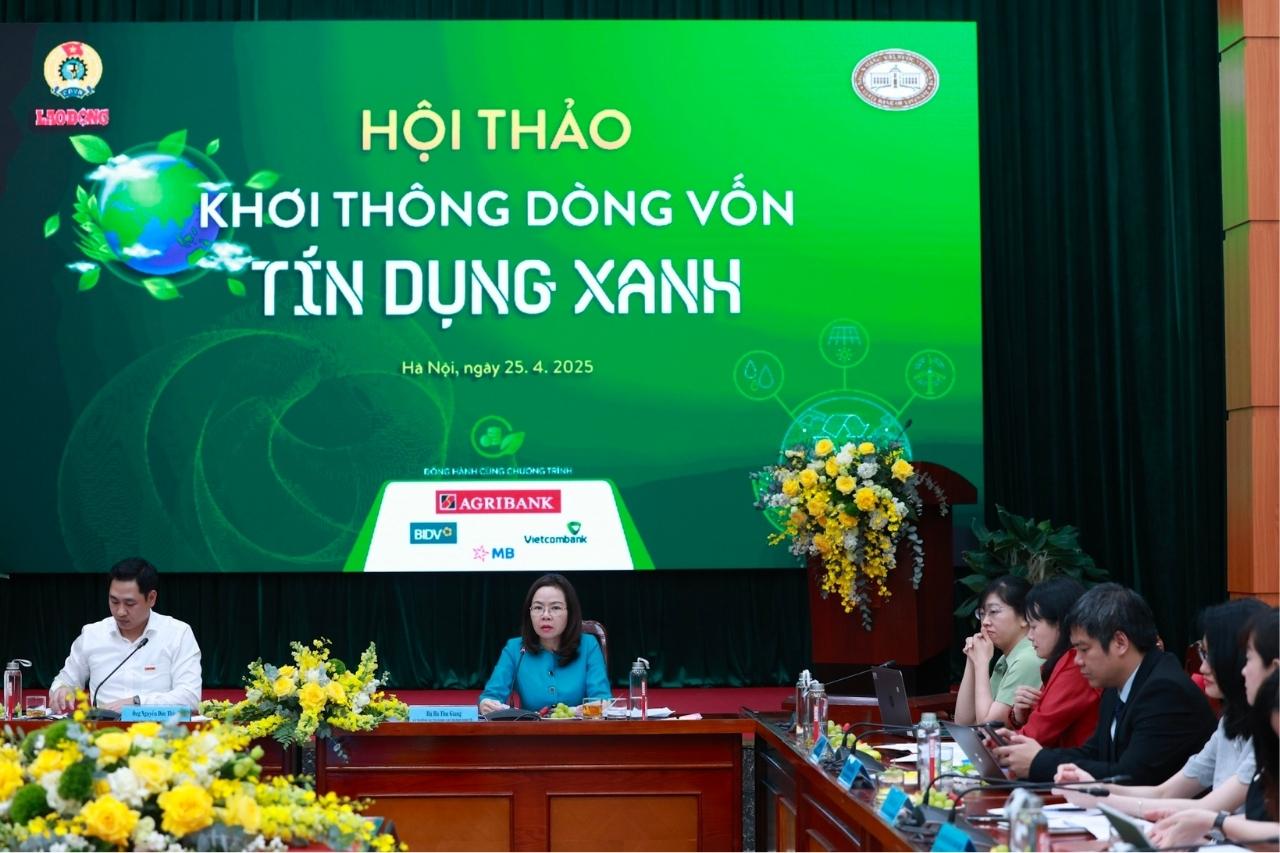
The workshop was organized by the State Bank in coordination with Lao Dong Newspaper, taking place at 2:00 p.m. on April 25, 2025 at the headquarters of Lao Dong Newspaper (No. 6 Pham Van Bach, Cau Giay, Hanoi). The program was broadcast live on Lao Dong Electronic Newspaper (www.laodong.vn) and Lao Dong Newspaper's Fanpage.
The program was attended by leaders of the State Bank of Vietnam, representatives of the Ministry of Agriculture and Environment, economic and financial experts, representatives of commercial banks, enterprises and financial institutions.
The event is also part of the Green Transformation Day 2025 event series organized by Lao Dong Newspaper, officially launched with the theme "Green Transformation - Joining hands for a sustainable Vietnam" on March 28, 2025.
In Vietnam, green finance has been present for more than a decade, but the scale is still modest. Outstanding green credit accounts for only about 4.6% of the total outstanding loans of the economy.
Unblocking green credit capital flows is not only an urgent requirement, but also a strategic problem, requiring strong and drastic coordination from the Government, the financial - banking system, businesses and the whole society.







